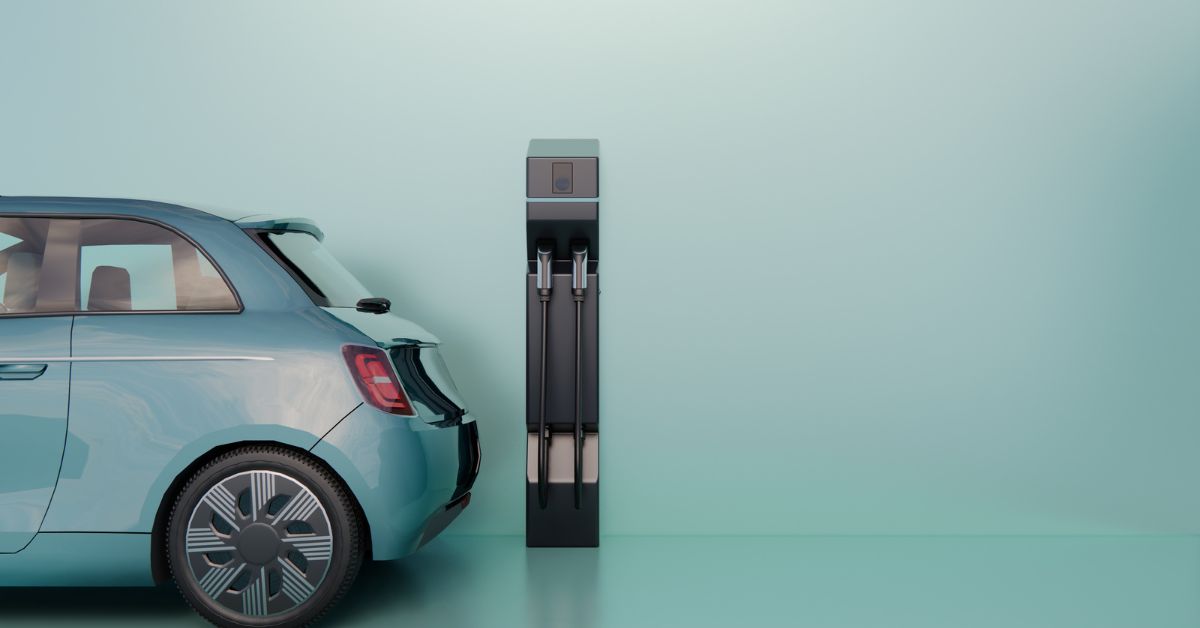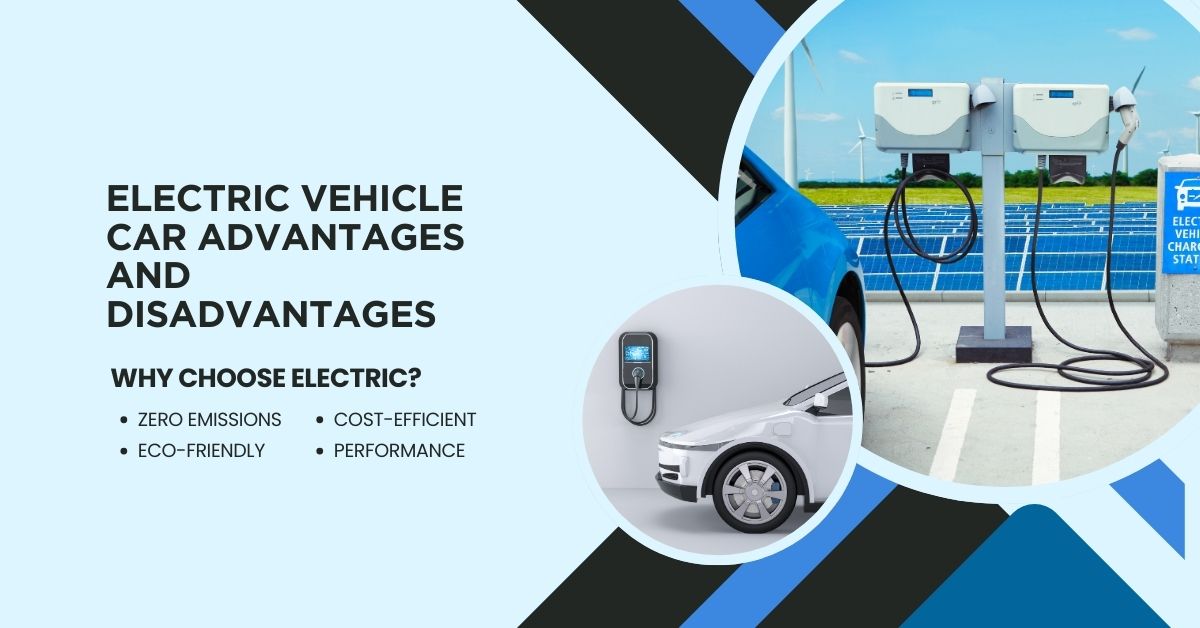Electric Vehicle Car Advantages and Disadvantages
Know the details about Electric Vehicle Car Advantages and Disadvantages, detailed information of Electric Vehicle car Advantages and Disadvantages.
Advantages of Electric Vehicle Cars:
Electric vehicles (EVs) offer significant advantages, including lower running costs due to reduced fuel consumption and fewer maintenance needs since they have fewer moving parts. EVs produce zero tailpipe emissions, contributing to cleaner air and a lower carbon footprint. They’re also quieter, providing a smoother driving experience.
Disadvantages of Electric Vehicle Cars:
However, EVs come with challenges, such as higher upfront costs and limited driving range. Charging infrastructure is still developing, making long trips less convenient. Charging times are longer compared to refueling, and battery replacement costs can be expensive over time.
Table of Contents
Electric Vehicle Car Advantages and Disadvantages: A Comprehensive Guide
The global automotive industry is undergoing a significant transformation, shifting away from internal combustion engine (ICE) vehicles to electric vehicles (EVs). Electric cars are no longer just futuristic concepts; they are now a viable option for many consumers around the world. EVs are praised for their environmental benefits, innovative technology, and potential cost savings, but they also come with challenges that need to be considered. This comprehensive guide explores the advantages and disadvantages of electric vehicles, offering an in-depth understanding for anyone considering making the switch.
Advantages of Electric Vehicles
Environmental Benefits
One of the primary reasons for the rapid adoption of electric vehicles is their potential to reduce greenhouse gas emissions. Traditional gas-powered vehicles emit significant amounts of carbon dioxide (CO2) and other pollutants into the atmosphere, contributing to global warming and air pollution.
Lower Greenhouse Gas Emissions
EVs produce zero tailpipe emissions, meaning they don’t release CO2 or other harmful gases when driving. Even though generating the electricity that powers EVs can produce emissions, studies show that EVs still produce fewer total emissions compared to conventional vehicles, especially in regions where electricity generation relies more on renewable energy sources like wind, solar, or hydropower.
Reduction in Air Pollution
In urban areas, air pollution from gasoline and diesel vehicles is a major health concern. EVs can contribute to cleaner air in cities, leading to improved public health outcomes. The reduction in smog and pollutants like nitrogen oxides (NOx) and particulate matter (PM) means fewer respiratory and cardiovascular issues for the general population.
Energy Efficiency
Electric vehicles are significantly more energy-efficient than their gasoline counterparts. The efficiency of an internal combustion engine (ICE) vehicle is generally around 20-30%, while EVs can convert about 60-80% of the electrical energy from the grid to power the wheels.

Regenerative Braking
EVs often use regenerative braking systems, which recapture energy typically lost during braking and convert it into electricity to recharge the battery. This system enhances the overall energy efficiency of the vehicle and reduces wear on the braking system.
Direct Power to Wheels
Since EVs don’t rely on complex mechanical transmissions, they deliver power more directly to the wheels, resulting in less energy loss. This simplicity makes EVs inherently more efficient and offers smoother acceleration and driving experiences.
Lower Operating Costs
Electric vehicles can save owners significant amounts of money in the long term, particularly due to lower fueling and maintenance costs.
Reduced Fuel Costs
Electricity is generally cheaper than gasoline or diesel fuel, and the cost to charge an EV is often much lower than filling a gas tank. While exact savings vary depending on local electricity rates and fuel prices, many EV owners report saving hundreds of dollars annually.
Lower Maintenance Costs
EVs have fewer moving parts compared to ICE vehicles, which translates to lower maintenance costs. There’s no need for oil changes, spark plugs, or complex transmission repairs. EVs also experience less brake wear due to regenerative braking, further reducing the cost of ownership.
Incentives and Tax Credits
Many governments offer financial incentives for purchasing electric vehicles, which can significantly offset the upfront cost. These incentives may come in the form of tax credits, rebates, reduced registration fees, or access to carpool lanes, making EV ownership more appealing.
Performance Advantages
Electric vehicles offer a unique driving experience that often surpasses that of traditional gasoline-powered cars.
Instant Torque and Acceleration
EVs are known for their instant torque, meaning they can accelerate quickly from a standstill. This instant power delivery gives EVs a more responsive and smooth acceleration compared to ICE vehicles.
Quiet Operation
Electric motors are much quieter than internal combustion engines, leading to a more peaceful and enjoyable driving experience. The near-silent operation also contributes to reduced noise pollution, especially in urban areas.
Technological Innovation
Electric vehicles are often at the cutting edge of automotive technology, featuring innovations that enhance safety, convenience, and overall driving pleasure.
Autonomous Driving and Advanced Driver-Assistance Systems (ADAS)
Many EVs come equipped with advanced driver-assistance systems, such as lane-keeping assist, adaptive cruise control, and even full or partial autonomous driving capabilities. Manufacturers like Tesla, Rivian, and others are pushing the boundaries of what is possible in autonomous vehicle technology.
Connected Vehicles
EVs are generally more connected than their ICE counterparts, offering features like over-the-air (OTA) software updates, integrated infotainment systems, and enhanced connectivity options for smartphones and other devices. These connected features allow EVs to improve their functionality over time, making them more future-proof.
Disadvantages of Electric Vehicles
While electric vehicles have numerous advantages, they also come with a set of challenges that potential buyers should be aware of.

Higher Upfront Costs
One of the primary barriers to widespread EV adoption is the higher upfront cost of purchasing an electric vehicle. Although prices are coming down as battery technology improves and production scales up, EVs can still be significantly more expensive than their gasoline-powered counterparts.
Battery Costs
The battery pack is the most expensive component of an electric vehicle, and while battery prices are dropping, they still account for a large portion of the vehicle’s cost. Although many EVs offer long-term savings through lower fuel and maintenance costs, the initial purchase price may deter some buyers.
Luxury Branding
Many of the early EV models were positioned as premium or luxury vehicles, which contributed to higher prices. Although more affordable models are becoming available, a perception remains that EVs are only for wealthier consumers.
Range Anxiety
“Range anxiety” refers to the fear that an electric vehicle will run out of charge before reaching a charging station, leaving the driver stranded.
Limited Range
While modern EVs can travel significantly further on a single charge than older models, their range still falls short of most gasoline-powered vehicles. Depending on the model, an EV can typically travel between 150 to 400 miles on a full charge. However, factors like weather, driving habits, and terrain can affect range, and long-distance trips may require careful planning to ensure access to charging infrastructure.
Charging Infrastructure
The availability of charging stations is still limited compared to gas stations, particularly in rural or less densely populated areas. While urban areas and highways are seeing rapid growth in charging networks, the lack of widespread infrastructure can be a concern for potential EV buyers.
Longer Refueling Times
Charging an electric vehicle takes significantly longer than refueling a gasoline-powered car. While advancements in fast-charging technology are reducing the time it takes to charge an EV, it still typically takes 30 minutes to several hours, depending on the charging method and the size of the battery.
Home Charging
Most EV owners charge their vehicles at home overnight, which is convenient but may not be feasible for people who live in apartments or lack access to a dedicated parking space with a charging outlet. For those without home charging options, relying solely on public charging stations can be inconvenient and time-consuming.
Fast-Charging Limitations
Although fast-charging stations can significantly reduce charging time, they are not as widely available as standard chargers and can still take 30-60 minutes to provide a full charge. Furthermore, repeated use of fast chargers can degrade battery life over time.
Battery Life and Degradation
The battery in an electric vehicle will degrade over time, reducing its capacity and the vehicle’s range. While modern batteries are built to last for many years, they still represent a potential long-term cost.
Decreasing Range
As batteries degrade, the range of an electric vehicle will gradually decrease. This can be a concern for owners who plan to keep their vehicles for extended periods. Manufacturers often offer warranties on batteries (typically around 8 years or 100,000 miles), but replacing a battery outside of warranty can be expensive.
Environmental Impact of Battery Production
While EVs are cleaner during their operational life, the production and disposal of lithium-ion batteries have environmental consequences. Mining for materials like lithium, cobalt, and nickel can lead to environmental degradation and human rights issues. However, the industry is working to improve recycling methods and reduce the overall environmental impact of battery production.
Dependence on Electricity
While electric vehicles can reduce reliance on fossil fuels, they also introduce a new dependency on electricity, which may not always come from renewable sources.

Power Grid Strain
As EV adoption increases, the demand for electricity will rise, potentially straining the power grid in some regions. This could lead to higher electricity prices or even power outages during peak usage times. Managing this increased demand will require investment in grid infrastructure and renewable energy sources to ensure a sustainable and reliable supply of electricity.
Carbon Footprint of Electricity Generation
The environmental benefits of electric vehicles depend on how the electricity used to charge them is generated. In regions where electricity comes primarily from coal or natural gas, the carbon footprint of charging an EV may be higher than in areas that rely more on renewable energy sources. The shift toward cleaner energy grids is crucial to maximizing the environmental benefits of EVs.
FAQs About Electric Vehicle Car Advantages and Disadvantages
Q1. What are the main advantages of owning an electric vehicle (EV)?
The key advantages of owning an EV include lower running costs, reduced emissions, less maintenance, and quiet operation. EVs are also more environmentally friendly and offer a smoother driving experience.
Q2. How do electric vehicles contribute to reducing carbon emissions?
EVs produce zero tailpipe emissions, which significantly reduces their overall carbon footprint, especially when charged using renewable energy sources like solar or wind power.
Q3. Are electric vehicles more cost-effective than petrol or diesel cars?
While EVs may have a higher upfront cost, they are more cost-effective in the long run due to lower fuel and maintenance costs. Charging an EV is generally cheaper than refueling a traditional car, and fewer moving parts reduce repair expenses.
Q4. What are the common disadvantages of electric vehicles?
Some common drawbacks include limited driving range, long charging times, and a smaller charging infrastructure compared to gas stations. Additionally, EVs can be more expensive to purchase upfront, and battery degradation may be a concern over time.
Q5. How long does it take to charge an electric vehicle?
Level 1 (standard outlets) can take 8-12 hours, while Level 2 (home or public chargers) typically takes 4-6 hours. Fast chargers can recharge an EV to 80% in 30-60 minutes.
Q6. Do electric vehicles perform well in cold weather?
EV performance can be affected by cold weather, leading to reduced battery efficiency and a shorter range. Cold temperatures require more energy for heating, which impacts overall performance.
Q7. Are electric vehicles safe compared to traditional cars?
Yes, electric vehicles undergo the same safety testing as traditional cars. In fact, EVs often have a lower center of gravity due to their battery placement, making them less prone to rollovers.
Q8. What is the typical lifespan of an electric vehicle battery?
EV batteries are designed to last 8-15 years, depending on usage and conditions. Most manufacturers offer warranties of 8 years or 100,000 miles for the battery pack.
Q9. Is the electric vehicle charging infrastructure sufficient for long trips?
While the EV charging network is growing rapidly, it still lags behind the availability of gas stations. However, planning routes with available charging stations helps EV owners manage long trips efficiently.
Q10. What impact do electric vehicles have on the environment beyond emissions?
Although EVs reduce tailpipe emissions, the manufacturing process, especially for batteries, can have a higher environmental impact. Mining for lithium and other metals used in batteries is resource-intensive, but advancements in recycling and sustainable practices are helping reduce this impact.
Conclusion: A Balanced Perspective
Electric vehicles represent a significant shift in the automotive landscape, offering a range of benefits from environmental sustainability to lower operating costs and cutting-edge technology. However, they also come with challenges, including higher upfront costs, range limitations, and charging infrastructure concerns.
For consumers, the decision to switch to an electric vehicle depends on various factors, including driving habits, access to charging, and personal values regarding environmental impact. As the technology continues to evolve, and governments and industries invest in better infrastructure and more affordable options, electric vehicles are poised to become the dominant form of personal transportation in the coming decades.
While the road ahead may have its obstacles, the future of electric vehicles is undeniably bright, and understanding both the advantages and disadvantages will help consumers make informed choices in this rapidly changing market.
Click here to learn more about Electric Vehicle Car Advantages and Disadvantages
Click here to learn more about Electric Vehicle Car Disadvantages
